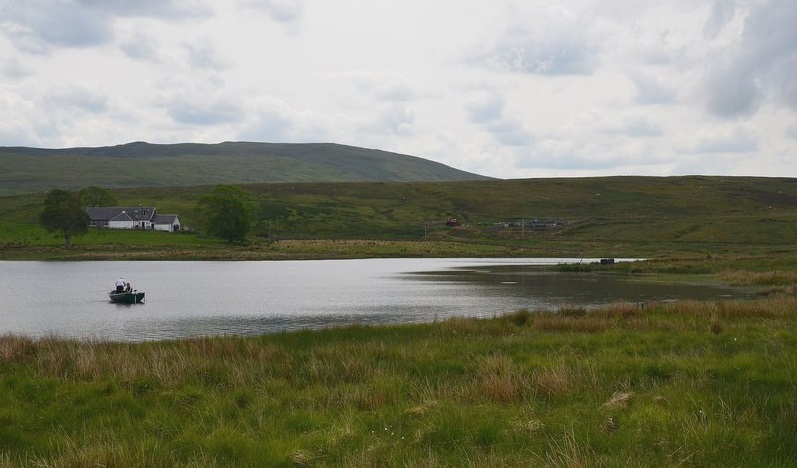.
Reservoir
Those who can still see through accreting years
Are getting scarce, those who can lift such veil
To remember when the Corps of Engineers
Dammed a minor river to end its tale
Of flood and misery among the local
Communities of farmers and the like.
The reservoir’s now ageless as the focal
Point of recreation, where locals hike,
Bike, or sail the glittering waters, or troll
For monster blues or flatheads that will lurk
Waterlogged roads and hedgerows for a shoal
Of sunfish—ambush loiters in the murk.
And when there is a certain slant of light
On sunny afternoons, some anglers search
The clearish depths, hoping to catch the sight
Of a submerged, forsaken small-town church.
.
.
Stephen M. Dickey is a Slavic linguist at the University of Kansas. He has published widely on Slavic verbal categories, and has published translations of Bosnian, Croatian, and Serbian fiction and poetry including Meša Selimović’s Death and the Dervish, Borislav Pekić’s How to Quiet a Vampire, and Miljenko Jergović’s Ruta Tannenbaum. He has published poetry in various journals including Shot Glass Journal, Trinacria, The Lyric, Rat’s Ass Review, Lighten Up Online, Better Than Starbucks, Asses of Parnassus, and Blue Unicorn.















I love that you gleaned a line from Dickinson in the last stanza 🙂
I have a Corps of Engineers created reservoir, Lake Lanier, near my house, and it’s interesting to hear local lore about it’s creation – including the town with a group of squatters who refused to leave and were drowned!
That submerged church is going to stick with me.
Thanks Jeremiah,
I enjoyed that the Dickinson line could fit into a completely different scene.
I have been wondering how many of these Corps of Engineers reservoirs were made, where, and of course, what the unsung histories are.
I looked up Lake Lanier, and it’s—Clinton Lake can only be described as a mud pit in comparison.
beautiful, that is.
pretty good alright
Thank you, sir.
The image of a submerged town, or a buried city, or any hidden place that was once inhabited, is (for me at least) a sure-fire subject of interest. Dickey does not broach the subject at first — we are simply told of a reservoir created by the Corps of Engineers, and how it is a place of recreation for people. It is only when he speaks of “waterlogged roads and hedgerows” that the sunken town confronts the reader, and then he is suddenly hit with the unsettling image of a “submerged, forsaken small-town church.”
The poem really struck me, because one of my most memorable dreams from childhood was that of walking on a sandy shore. The sand gave way below me, and I fell into a completely buried church with a steeple and bell. I saved myself by catching at the crossbeam that held the bell and hung there, over the dark and cavernous bottom. I never forgot the dream, and it was the beginning of my obsession with all antiquities and ancient mysteries.
I have been obsessed with the same myself since I was a kid, starting with fossils and the occasional arrowhead. Once that bug bites, you can never shake it.
I enjoyed your poem, Stephen. The reveal is really well done, and as Joseph says, who can resist the myth and mystery of a submerged or abandoned village or town.
Thanks for the read.
Thanks, Paul. I am glad you liked it.
You are flirting with deep waters here, Stephen. Here in Massachusetts we still wonder about the several small towns lost beneath the water of the Quabban Reservior, which was created for the sole purpose of keeping Boston well hydrated. Let those nefarious politicians drink their own sweat.
Kip, I can only concur with your first statement. When one starts messing around with historical stuff beyond History™, an eerie feeling sets in.
The title “Reservoir” has a nice double meaning, referring to the body of water as such (including its recreational purposes), and as a holder of what is remembered by “those who can still see through accreting years.” At least for a time, it preserves what its creation destroyed.
As to other Corps of Engineers projects, the Los Angeles River is ongoing, with a complicated series of events. There was a terrible flood in the 1930s, and in 1940 the Corps did not try building a reservoir, but began turning the riverbed into concrete, with resultant loss of the water. Freeways now pass over the huge empty concrete basin that gets a little wet whenever there is heavy rain. However, the Corps has replied to complaints of destruction of an ecosystem, and a stretch of the river is once again flowing, though the concreted area looks just as dry as it has for decades. I don’t know what there is to be sung in this case!
That sounds less than enticing. I imagine there’s only so much lyricism to be pressed out of the Corps of Engineers, at a remove at least.
“Reservoir” brought back the memory of the wonderful summer vacations spent in a cabin at Camp Judson, a Christian retreat in the Black Hills. Then as a teenager, it was replaced by a reservoir called Lake Pactola. I still remember the sadness of my family.
So a part of you is at the bottom of that pool, I can understand the sadness.
Not long ago, I read a book about a village that was sacrificed for a reservoir. In the 1930s the Bridgeport Hydraulic Co. set its sights on the Saugatuck River Valley in southern Connecticut. The people living in the area, known as Valley Forge, were primarily Welsh farmers and iron workers. They didn’t stand a chance against corporate influence and the government’s power of eminent domain. They were bought out on the cheap. Some moved their homes. Other structures were burned down. An entire community and way of life – lost in the name of progress.
Something similar happened in the 1950s in Egypt, with the building of the spectacularly useless Aswan Dam on the Nile. Creation of the dam caused immense flooding of certain historically important areas, and an entire pharaonic temple (which had been chiseled directly out of a cliffside) had to be sawn out and removed to higher ground. Besides this disruption, the surrounding desert, which had long been a major source of ancient papyrus texts fragments, was now flooded and inaccessible.
And the Aswan Dam? A total flop. It helped Egyptian farming only marginally, it wrecked the fishing grounds in the Mediterranean by preventing the nutrient-rich Nile water from replenishing that sea, and the dam is now so heavily silted up at the base that it is nothing more than a big obstacle in the river.
Stupid thinking, stupid plans, stupid results. That’s what a great deal of the modern world is.
I’m guessing they were paid a fraction of what their land was worth, which is what happened here.
There’s one farmstead at the edge of the water I take my my boys to and let them scour with metal detectors. They are excited to scrounge ploughshares, tractor parts, etc. My blood runs cold toward anything besides a lost bag of gold coins that just won’t make those needles flicker.